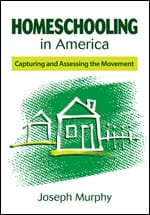 An oft-overlooked sector in American K-12 education has also been its most rapidly growing: homeschooling. There are currently more than two million home-school students in the U.S., marking a growth rate of between 7 and 12 percent per annum since the 1970s. This book-cum-literature review profiles this expanding sector, tracking its prevalence, demographics, history, rationale, instructional methods, and impact—drawing data and conclusions from an impressive seventeen pages of references. Many points are unsurprising, though the breadth of data provides a uniquely robust representation of this group: Homeschoolers tend to be white (93 percent), conservative (93 percent), and squarely in the middle class (with wealthier families opting for private schools and poorer families lacking the economic flexibility needed to keep a parent out of the workforce). The vast majority are Christian (92 percent)—the rise in homeschooling parallels the rise in Christian fundamentalism in the states—though Muslims mark the fastest growing sub-set of homeschoolers over the past few years. The average home-schooled family has two to three children; the parents are about 20 percent more likely to have a college degree than non-home-school parents; and the children score higher on standardized tests than their public school peers. Homeschooling matches geographic population dispersion in all regions save the Northeast, where it is underrepresented. The number of homeschoolers currently tops the number of charter-goers in the U.S., yet little attention is paid to the former. Kudos to author Joseph Murphy for compiling this work—and for spotlighting this shadowed sector in K-12 education.
An oft-overlooked sector in American K-12 education has also been its most rapidly growing: homeschooling. There are currently more than two million home-school students in the U.S., marking a growth rate of between 7 and 12 percent per annum since the 1970s. This book-cum-literature review profiles this expanding sector, tracking its prevalence, demographics, history, rationale, instructional methods, and impact—drawing data and conclusions from an impressive seventeen pages of references. Many points are unsurprising, though the breadth of data provides a uniquely robust representation of this group: Homeschoolers tend to be white (93 percent), conservative (93 percent), and squarely in the middle class (with wealthier families opting for private schools and poorer families lacking the economic flexibility needed to keep a parent out of the workforce). The vast majority are Christian (92 percent)—the rise in homeschooling parallels the rise in Christian fundamentalism in the states—though Muslims mark the fastest growing sub-set of homeschoolers over the past few years. The average home-schooled family has two to three children; the parents are about 20 percent more likely to have a college degree than non-home-school parents; and the children score higher on standardized tests than their public school peers. Homeschooling matches geographic population dispersion in all regions save the Northeast, where it is underrepresented. The number of homeschoolers currently tops the number of charter-goers in the U.S., yet little attention is paid to the former. Kudos to author Joseph Murphy for compiling this work—and for spotlighting this shadowed sector in K-12 education.
SOURCE: Joseph Murphy, Homeschooling in America: Capturing and Assessing the Movement (Thousand Oaks, CA: Corwin, 2012).
